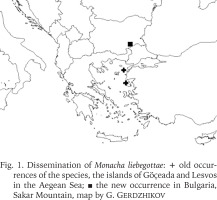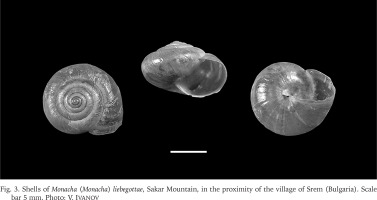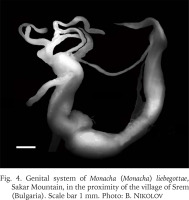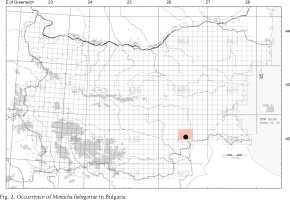The greatest variety of species of the genus Monacha Fitzinger, 1833 has been registered in Turkey (Hausdorf & Páll-Gergeli 2009). Furthermore, during the examination of Monacha from Turkey fifty species have been identified (Hausdorf 2000). Until now, only 6 species of Monacha have been recorded in Bulgaria; in future research, it is very likely that other species of this genus will be registered (Irikov 2008). Here, we report the first finding of Monacha liebegottae Hausdorf, 2000 on the territory of Bulgaria and the European continent (preliminary report in Irikov & Gerdzhikov 2016).
Genus Monacha Fitzinger, 1833
Monacha (Monacha) liebegottaeHausdorf, 2000
Locality: Bulgaria (Fig. 1), Sakar Mountain, River Tundzha in the close proximity of the village of Srem, Topolovgrad Municipality (Fig. 2), 42°03'11.0″N, 26°28'26.1″E, 82 m alt., floodplain deciduous forest by River Tundzha, 28 November 2009, collected by G. Gerdzhikov.
Fig. 1
Dissemination of Monacha liebegottae: + old occurrences of the species, the islands of Göçeada and Lesvos in the Aegean Sea; ■ the new occurrence in Bulgaria, Sakar Mountain, map by G. Gerdzhikov

Shell (Fig. 3): Depressed conical globular; the main whorls have clearly visible, plaited growth ribs; brownish corneous in colour; the aperture is predominantly circular, rather than elliptic; the upper part of the aperture clearly descends downwards; the rim of the aperture is pointed, unexpanded, with a light inner edge; the umbilicus is narrow, almost hidden by the twisted columellar end.
Fig. 3
Shells of Monacha (Monacha) liebegottae, Sakar Mountain, in the proximity of the village of Srem (Bulgaria). Scale bar 5 mm. Photo: V. Ivanov

Genital system (Fig. 4): The penis is swollen, clearly distinguishable from the epiphallus, connected to it by thin muscle filaments (ligament). The appendix is slender, long, cylindrical and wedges a little higher than the middle of the vagina. The mucous glands are slightly branched and wedge insignificantly proximally from the appendix. The sizes of some of the parts of the genitalia are presented in Table 1, compared with data given by Hausdorf (2000).
Fig. 4
Genital system of Monacha (Monacha) liebegottae, Sakar Mountain, in the proximity of the village of Srem (Bulgaria). Scale bar 1 mm. Photo: B. Nikolov

Table 1
Size of some parts of the genitalia of Monacha liebegottae (in mm) from Sakar Mountain, River Tundzha in the proximity of the village of Srem (Bulgaria). Abbreviations: ap – vaginal appendix; ep – epiphallus; fl – flagellum; p – penis; vap – vagina up to the base of the vaginal appendix; vgm – vagina up to the mucous glands; vt – total length of the vagina

The greatest variety of the species of genus Monacha has been identified in Asia Minor, and more specifically, in Turkey (Hausdorf 2000). Some of these species are widely dispersed in the Asia Minor biogeographical zone, while others are significantly rarer, with local distribution (Neiber & Hausdorf 2017). M. liebegottae, described by Hausdorf (2000) is among those with a restricted distribution. During our research on Sakar Mountain, M. liebegottae has been registered for the first time on the European continent, the more remarkable since it was previously known only on two islands in the Aegean Sea – Göçeada and Lesvos (Fig. 1). The contemporary disjunctive distribution of the species probably results from its preservation in specific climatic refugia. The first establishment of the species outside the Aegean region and its finding on the European mainland suggests its relict character and probably much broader dispersion in past historical times. Thus, it is likely that more localities will be found, for example in the European part of Turkey; this will enable us to learn more about its origins.


